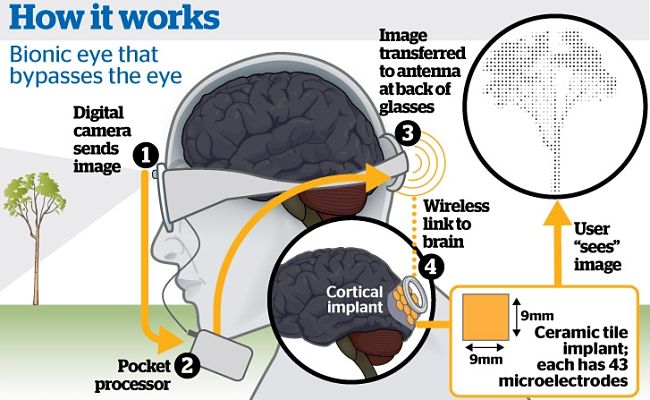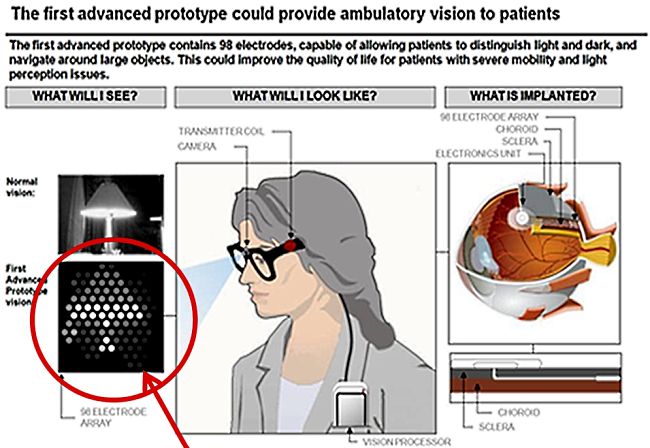Four Paths in Race for the Bionic Eye
Recent Developments suggests that the biotic eye will transform from science fiction to reality in three to five years offering hope for the blind and visually impaired.
The race is on to develop the new bionic eye following in the footsteps of the international success of the bionic ear.
There have been major investments of Government and Private Funds into the research
Teams from Australia, Germany other European countries, American Universities and a number of private project teams are engaged in the quest using four different approaches that include:
- Subretinal implants,
- Epiretinal implants,
- Optic nerve stimulation and
- Cortical prosthetics.
This quote from Charles Darwin highlights the elegance and functional creativity of eyes
' To suppose that the eye with all its inimitable contrivances for adjusting the focus to different distances, for admitting different amounts of light,
and for the correction of spherical and chromatic aberration, could have been formed by natural selection, seems, I freely confess, absurd in the highest degree.'
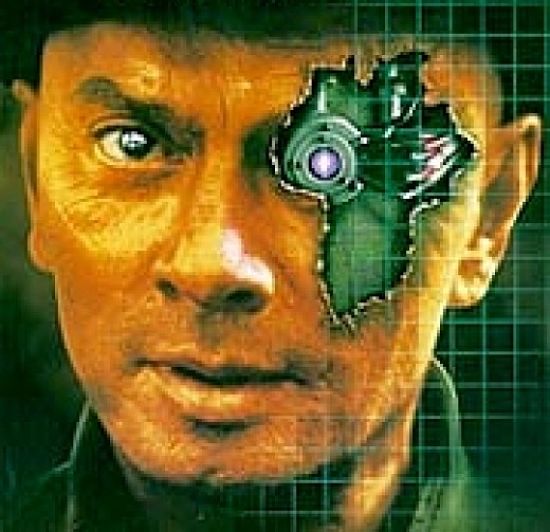
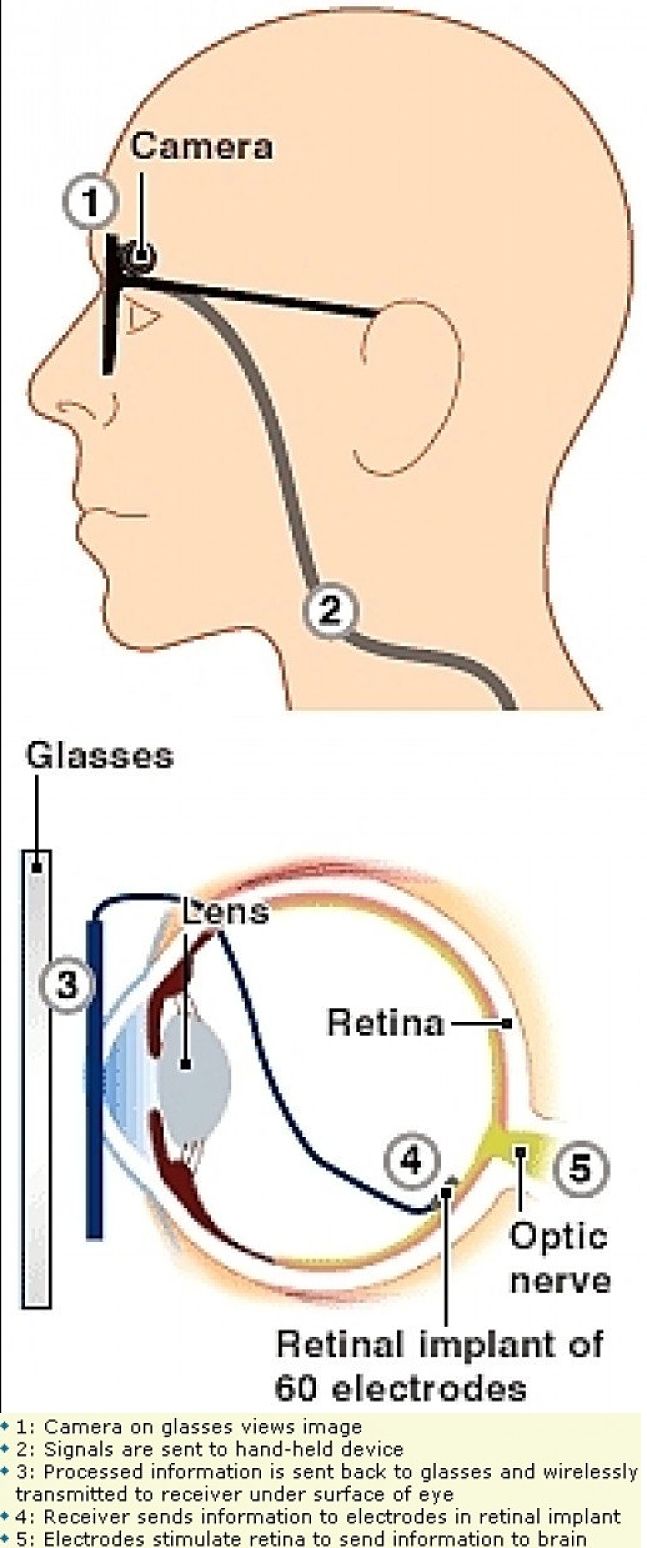
Four Approaches with Four Implant Targets
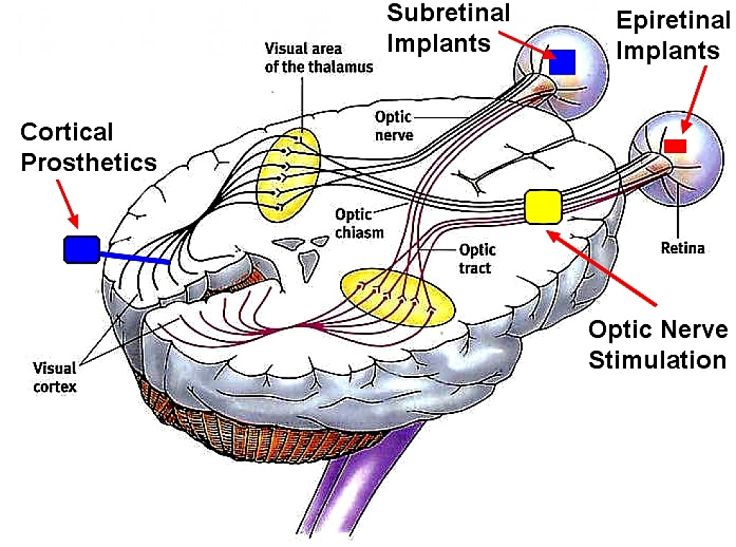
|
Bionic Eye Approach
|
Location of Implant
|
Requirements of the Patient
|
Fault addressed
|
|
|---|---|---|---|---|
|
Subretinal implants
|
Inner surface of the retina
|
Fully functioning eye, except for photoreceptors
|
Photoreceptors damaged
|
|
|
Epiretinal implants
|
Back of the Retina
|
Retina nerves functioning
|
Eye damaged but retina intact, photoreceptors damaged
|
|
|
Optic Nerve Stimulation
|
Sleeve around the optic nerve
|
Functioning optic nerve
|
Eye damaged including non-functioning retina
|
|
|
Cortical Prosthetics
|
Direct stimulation of the visual cortex bypassing the eye
|
Functioning visual cortex
|
All damage to the eyes and optic nerves
|
Charles Darwin did go on to explain how natural selection could account for the evolution of the human eye.
In fact the human-type 'Camera Eye' has developed several times in the animal kingdom and is one of the most famous examples of convergent evolution. The camera eye of cephalopods (for example squid and octopus), vertebrates (for example humans and mammals) and cnidaria (for example the humble, but terrifying box jellyfish) are remarkably similar (see images below). All these 'camera' eyes evolved independently from a distant common ancestor that had a very simple photoreceptive spot.
The box jellyfish have tiny camera style eyes with cornea, lens, and retina with ciliated light receptors. The jellyfish are active swimmers that use their eyes to change directional changes in response to visual stimuli. They have four light receptors (rhopalia) on their 'bells', each with 6 eyes (giving a total of 24 eyes). They have four types of eye: paired slit eyes, paired pit eyes, an upper lens and a lower lens.
The similarity of the structures in the various animals, despite the complex nature of the organ, shows perhaps that there is an optimal solution for sensing vision.
The complexity of the eye has meant that it has been very difficult to reproduce its function artificially. The bionic eye is much more complicated than the bionic ear and much harder to achieve.
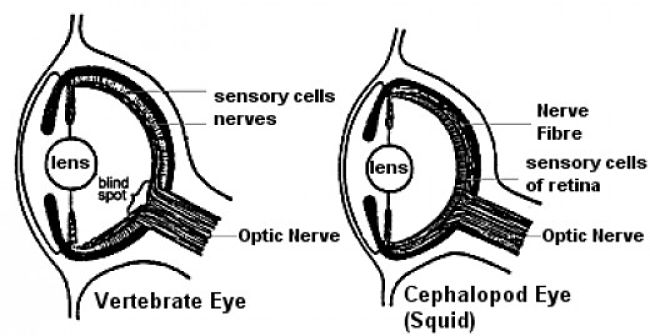
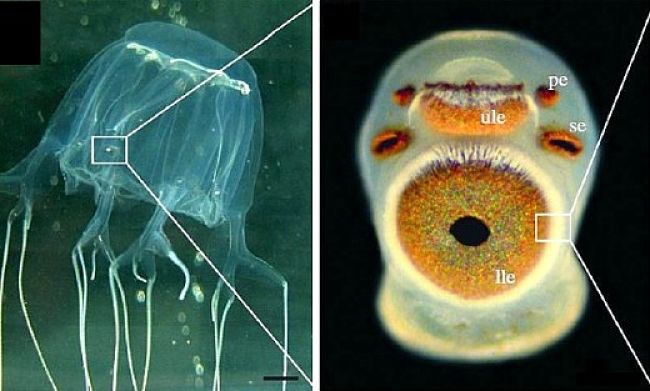
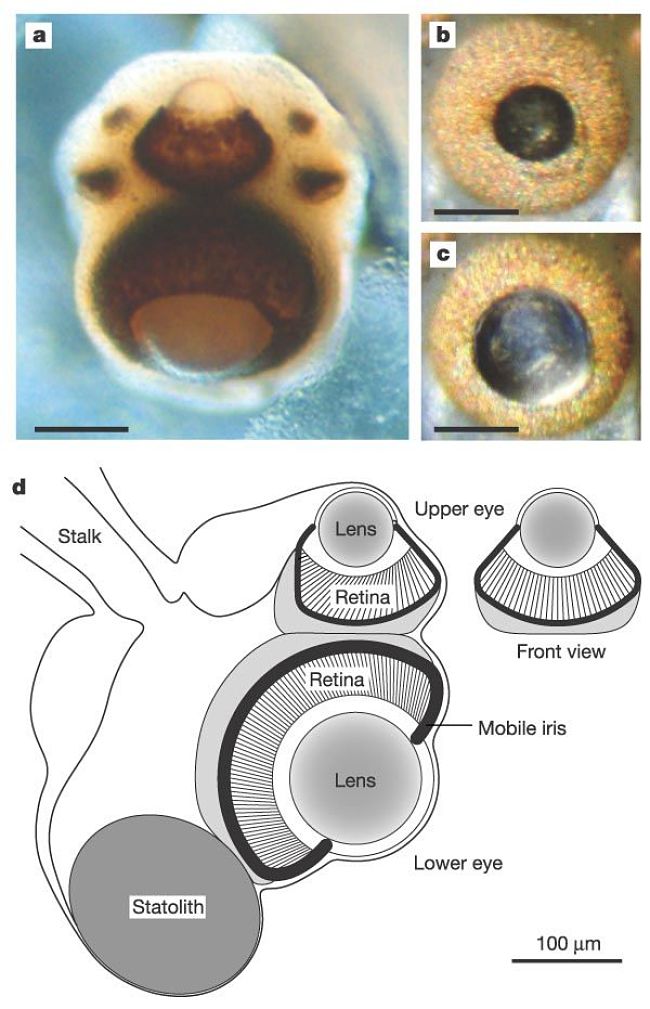
The Epiretinal Approach
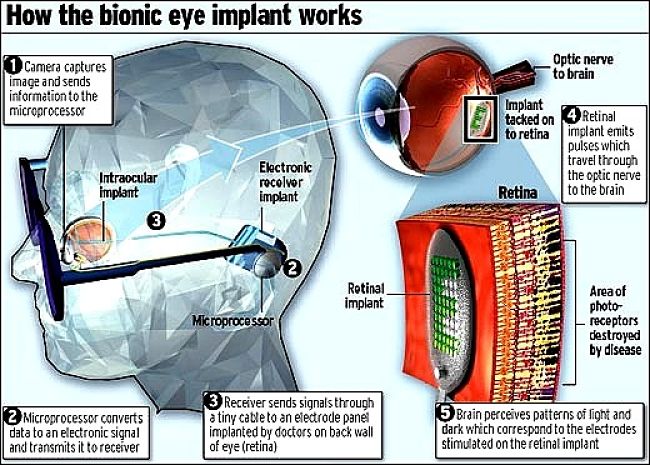
The Epiretinal approach - uses an external camera which transmits information to a relay chip placed on or at the back of the retina. This does not require a functional eye as such. The device has to pre-process the video image before sending it to the retina, and so it is an artificial signal rather than direct stimulation of the photoreceptors. Patients need time to learn how to process the information transmitted down the optic nerve to the brain. The camera does not provide an exact simulation of normal retina outputs. This method can help more patients because it effectively replaces the entire eye and only relies on a functioning retina and optic nerve (not the photoreceptors). The actual epiretinal device is a 4 x 5 mm circuit device with 16 electrodes in a 4 x 4 array. The bionic eye consists of the following elements:
- A miniature video camera fitted in a pair of dark glasses which sends images to
- a radio receiver implanted next to the eye of the patient. This then sends a signal on to the implanted device (signal transceiver, stimulation unit and electrode array)
- a small chip of platinum and silicon, about 4mm square, that sits on the retina. It has electrodes that stimulates the retina.
- the ganglion cells below the retina, then transmit visual information on to the optic nerve and
- transmission of the signal to the brain, which can then construct a visual image.
This bionic eye, which is being developed in Australia and other countries is suitable for patients with diseases such as macular degeneration and retinitis pigmentosa that have left more than 50,000 Australians visually impaired. The Australian team hopes to have the first phase device under trails by 2013. This device should provide enough vision for people to be able to move around and see the outline of obstacles. In another five or six years, the next phase will be developed with greatly enhanced capability with 1,000 electrodes allowing people to recognise faces and read large print. Other research teams working on epiretinal implants include a team at Harvard University and the German Northern Consortium, at the Bonn University.
The Subretinal Implant approach
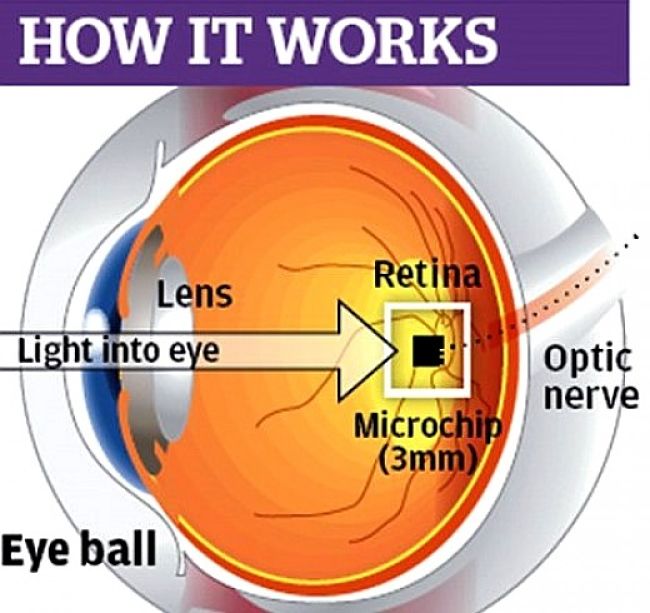
The Subretinal Implant depends on an intact eyeball, as well as an intact retina with fully functioning bipolar cells, and the optic nerve and brain. This technology is focused on forms of blindness caused damage to photoreceptor cells, such as is caused by the disease retinitis pigmentosa, which is an inherited disorder that gradually destroys the retina. The implant is just 2 mm across and includes 1,500 to 5,000 microphotodiodes, each fitted with a stimulating electrode. The units are powered by incoming light and requiring no added current.
The chip is surgically implanted onto the surface of the retina and is designed to produce electronic signals similar to those produced by the photoreceptor layer. These sensors detect light, and generate a pulsed electrical signal that is fed to the bipolar cells.
The sensors mimic the way the natural photoreceptor cells work and hence require little learning on behalf of the patient, turning light into a pattern of electrical impulses. The device has been tested in Germany on three blind patients. Within a couple of days the patients were able to recognise objects on a table, tell the time from a clock, walk around a room with confidence and distinguish between subtle shades of grey.
Direct Stimulation of the Optic Nerve Approach
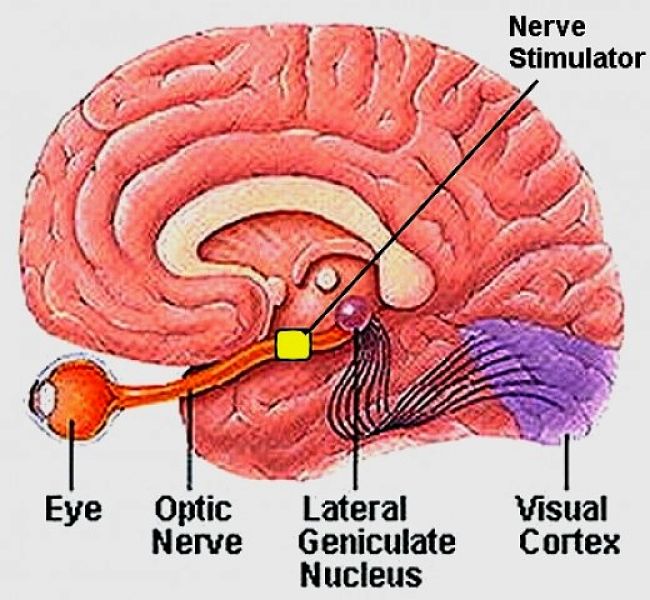
The optic nerve implant takes an entirely different approach using a spiral cuff nerve electrode that is wrapped around the optic nerve. An implanted tiny cuff around the optic nerve, stimulates the nerve fibres via a number of electrode. It preliminary trials it has been shown that very small currents generate the perception of phosphenes. The method is rather hit and miss as there is no way of knowing which nerves do what. Trial-and-error methods eventually worked to induce limited patterns that the patient could recognise.
The Cortical Implant Approach
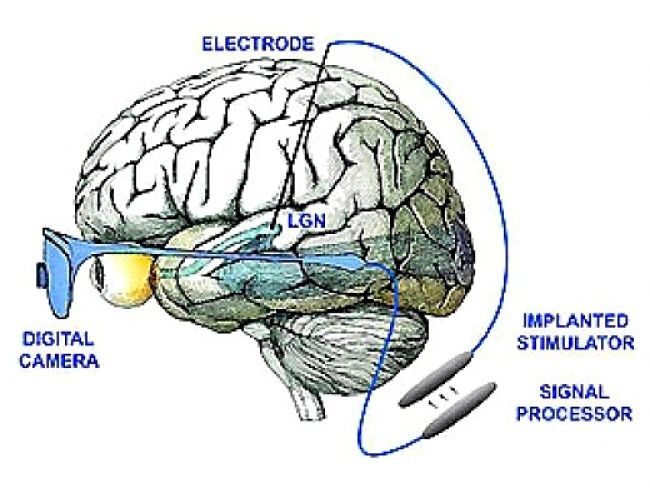
In this approach a device plugs directly into the visual cortex bypassing the eye, the optic nerve and most of the rest of the brain to directly stimulate the nervous system where the majority of visual processing takes place. Several teams are following the cortical implant route, including the US National Institutes of Health, and the University of Utah.
Conclusion
Who will win the Race?
Only time will tell which of the four approaches now being developed will work to produce functional artificial vision. In reality all four may be developed for various applications depending on the extent of the disability to the eye.
Each of the four approaches has disadvantages and advantages.Each approach also presents difficult technical problems and challenges in microelectronics, materials sciences, software and computational modelling.
However there is very substantial cause for optimism, since research has already progressed to various implanting trials. The next few years should see a rapid growth in progress, fuelled by the quest for scientific inquiry and commercial competition between teams.
The initial devices are likely to have low resolution with gradual improvements developed in subsequent years.
How the Resolution of Sensors has Improved
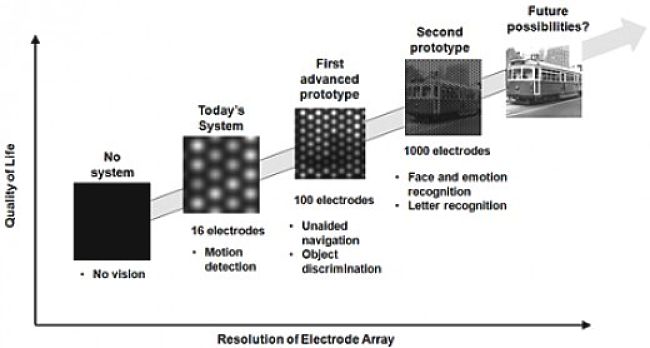
Related Eye and Home Remedy Articles
=> Do the Eyes Tell Someone is Lying or is Lying Eyes a Myth?
=> Home Remedy for Dry Eyes - Relief, Treatment and Prevention
=> Best Natural Allergy Remedies - Identify, Avoid Seasonal Allergens
=> Chamomile Tea Health Benefits, Uses and Remedies
=> Tips for Preventing Dry Eyes, Homemade Remedies
=> Health Benefits of Ginger - Nutritional Facts, and Dietary, Medicinal Benefits
